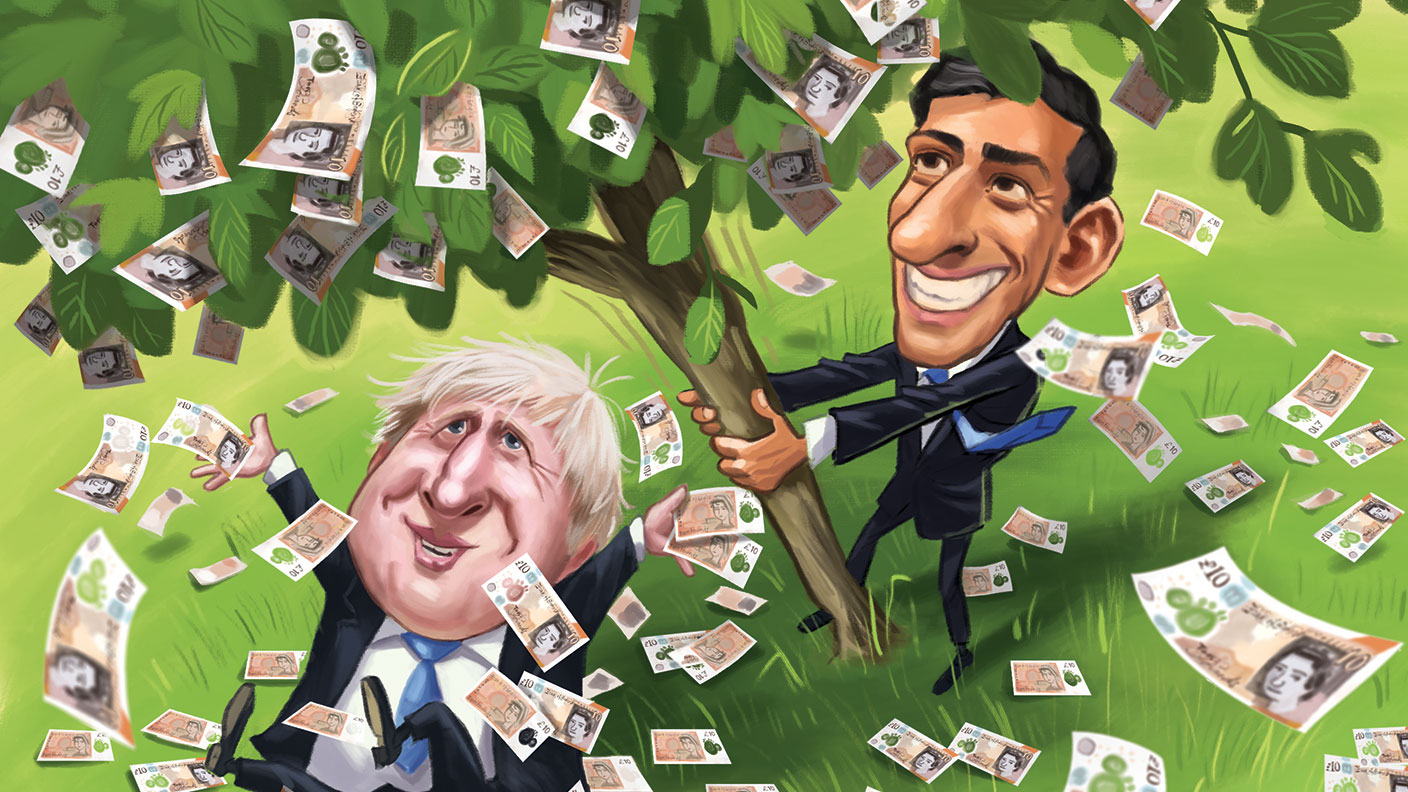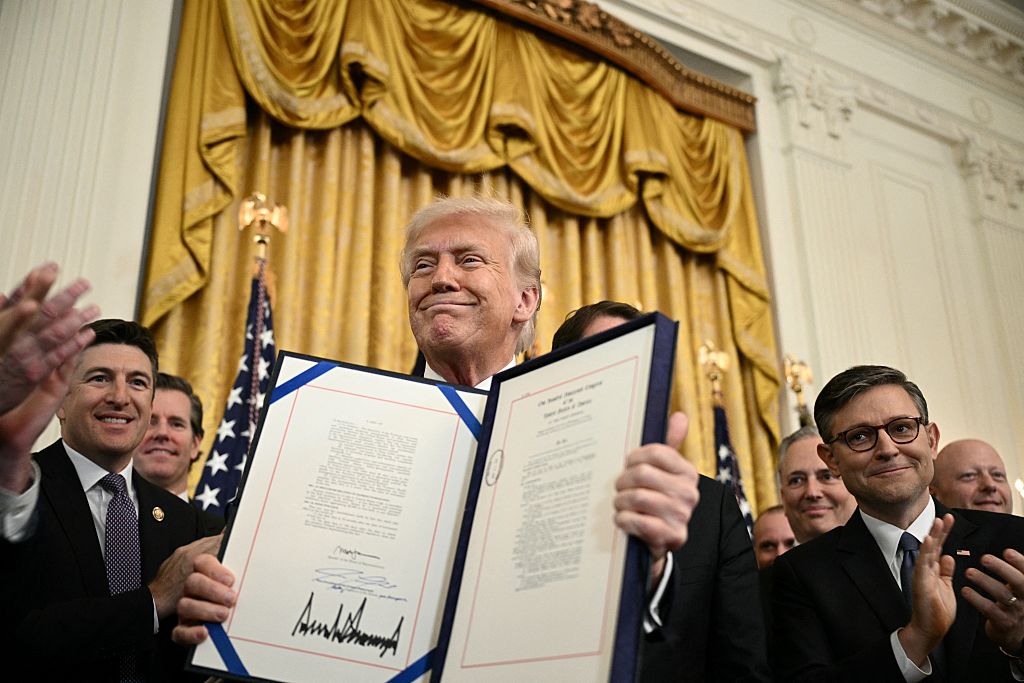MMT: the magic money tree bears fruit
“Modern Monetary Theory” is becoming modern monetary practice. But how far will policymakers go in this radical experiment, and at what cost? Stuart Watkins reports.


People who go through near-death experiences often report that their lives “flash before their eyes” – a rapid review of their life passes before their mind’s eye. A plausible theory to explain why this happens is that the brain, in an effort to prevent its own death, urgently reviews everything in its memory to see if there’s anything there that might help.
Something similar seems to happen at the societal level. When a crisis threatens life as we know it, we seem obliged to review every discarded idea that might help, even the crackpot ones. Perhaps basic income really is the answer – or a jobs guarantee. Perhaps Marx was right. There is, as H. L. Mencken said, always a simple solution at hand to every human problem: “neat, plausible, and wrong”.
Changing how we think about money
Take Modern Monetary Theory (MMT). For years, a growing movement of enthusiasts, hailing mainly from the left of the political spectrum, have been urging us to change the way we think about money. To the old-fashioned way of thinking, money is a social phenomenon, arising spontaneously as a matter of necessity to grease the wheels of trade. Governments, having no money of their own, levy taxes and in return protect property rights, organise the defence of the realm, and so on. What that “and so on” might entail is strictly limited by how much money the government can collect in taxes, or borrow.
MoneyWeek
Subscribe to MoneyWeek today and get your first six magazine issues absolutely FREE

Sign up to Money Morning
Don't miss the latest investment and personal finances news, market analysis, plus money-saving tips with our free twice-daily newsletter
Don't miss the latest investment and personal finances news, market analysis, plus money-saving tips with our free twice-daily newsletter
This, say MMTers, is all wrong. For them, money is and always has been a creature of the state. Once upon a time, the nascent state was faced with the complex problem of how to provide for its troops and keep them on the road. It came upon an ingenious solution. It paid its foot soldiers in state-issued tokens, then demanded taxes from the general populace, accepting only that token as payment. In this way, the state forced the populace to figure out what it was the soldiers needed and wanted and provide it in exchange for the tokens – in effect, the populace ceased to work for themselves and started working for the state.
It’s a simplified origin myth and the reality was no doubt more complex, but the story brings out the fundamental point: money is an invention of the state and the state doesn’t need to raise revenue by levying taxes. It mints the money tokens itself, then in effect buys whatever it is that it needs to meet its goals. The question of whether the state has enough money to do what it wants, or whether it can pay its debts, just doesn’t arise.
The state always has the money it needs and can therefore pursue social objectives such as full employment without worrying about whether it can afford it. (The theory, then, only applies to states such as Britain and the US, which issue their own currency and debt denominated in that currency.) Should the state issue more money than there are resources, then the result will be inflation, but that can always be reversed by cutting spending and raising taxes, thereby taking money back out of circulation again. Simple.
MMT arrives by the back door
But wrong? We may be about to find out. Governments and central banks are “backing into MMT” – not so much by embracing the new theory, more by “the sheer necessity of swiftly repairing the economic damage” from the virus, say Bluford Putnam and Erik Norland, economists at CME Group. When the government funds its spending by issuing debt that the central bank buys, as the UK government has, for example, then what we are seeing is in effect MMT in action.
Governments are pumping large amounts of money into economies to stop economic activity falling more than is necessary for the sake of public health. They are not worrying about deficits (at least for now). And the limits of spending and central-bank debt purchases are not being guided by considerations of affordability, since the central bank can always “print” more, but by whether too much inflation will be created.
As the governor of the Bank of England, Andrew Bailey, recently pointed out, the UK government would have run out of money in March if it hadn’t been for the central bank’s support. It bought £200bn of government bonds to ensure the government had sufficient money to get through the coronavirus crisis. Bailey, though, worries about the long-term effects of this, particularly about the growing perception that the bank has engaged in monetary financing of the government’s deficit.
In more normal times, this would be seen as an act of recklessness severe enough to bring Zimbabwe and the Weimar Republic to mind. Bailey has warned that such measures mustn’t become a permanent feature of the economy. Yet “nothing is so permanent as a temporary government programme”, as Milton Friedman warned and recent history confirms. (For MMTers, nominally independent central banks are effectively an arm of the government, another thing that they get basically right.)
Quantitative easing (QE) and ultra-low interest rates, too, were seen as radical experiments that would see us through and get us back to normal and yet more than a decade on, the experiments continue. Governments and central banks around the world are now in effect running MMT experiments, as Putnam and Norland point out: “Governments are trying to provide support for wage earners and loans and grants to corporations. Central banks are not only expanding their loans to banks and buying more government bonds, they are also going beyond their traditional limits and are now lending to corporations and local government authorities”. True, these programmes are “largely aimed at getting individuals and businesses through the worst of the pandemic and to put a floor under the economy”, but “new programmes to address the pace at which the economy can rebuild” are forthcoming. “More spending is on the horizon.”
The dangers lurking in the long term
True believers think that worriers like Bailey should relax and should indeed make MMT a permanent feature of the economy. And as Edward Hadas of Breakingviews points out in a review of a new book on the subject, Stephanie Kelton’s The Deficit Myth, the argument is a powerful one, up to a point. It is relatively clear that a government that issues money cannot run out of the stuff and the financial crisis suggests to some that large fiscal deficits can revive growth without pumping up inflation. But beyond that point is where the idea looks likely to get mugged by reality.
The most obvious problem concerns inflation. As Putnam and Norland warn, when something like MMT has been tried in the past – that is, when “an aggressively expansionary fiscal policy is supported by an accommodative central bank” – the result has been a dangerous inflationary spiral. “It takes... years and years to get inflation started, but once the spiral commences it is a vicious cycle of higher and higher inflation, the exit is extremely painful for the economy and to the politicians that oversee it.” And MMTers have no good answer to what should be done when that happens, beyond relying on politicians to cause a recession by cutting back on spending and raising taxes. Is this remotely realistic?
Another problem is the naive faith MMTers place in the ability of the state to create jobs and optimise resource use, as Hadas points out. Surely “corruption and incompetence are serious risks”? And “finding work that people can actually do well and that will help the economy requires many more difficult choices than are implied” by MMTers’ “talk about local control, a caring economy and environmental responsibility”.
The idea of a jobs guarantee, whereby the state promises a job to every worker who can’t get one in the private sector, is usually served up as part of the MMT package, but employment is not an end in itself, as Daniel Tenreiro puts it in the National Review. Employment is “beneficial only insofar as it increases consumption, output and productivity”. But a jobs guarantee, by definition, would employ workers only in the areas that private firms consciously avoid. If those areas seem unpromising to private firms, why would government-backed schemes perform any better? A jobs guarantee would divert low-skilled workers from private firms into the public sector, putting a “permanent drag on productivity”.
Such “neglect of the supply side is a constant in MMT theorising”, says Tenreiro. “Policymakers are right to take a more dovish stance on [government] debt. But they shouldn’t confuse MMT’s directional accuracy on that question with its soundness as a macroeconomic model. No number of accounting identities can belie the basic fact that in the long run, only innovation can spur growth. [State] capture of the economy is harmful... because it moves the factors of production from the hands of innovators to the hands of bureaucrats.”
Who will turn the spigot off?
Still, the likelihood is that MMT, or something that smells very like it, will continue to play a role as governments seek to boost post-Covid-19 economies. And although those implementing such policies may be nervous of the consequences, for the reasons outlined, and fully intend to reverse them when times are more “normal”, recent history suggests that won’t be easy. What does that mean for investors? As Vineer Bhansali points out in Forbes, investors will have noted that central banks have once again “opened up the money spigot”. Asset prices are close to all-time highs, even as the economy teeters and inflation appears subdued.
For investors based in countries that are monetarily sovereign states, the message from governments and the central banks seems clear for now: buy every dip in stocks, don’t worry about inflation and “spend like your life depended on it”. Buy stocks and bonds in monetarily sovereign countries such as the US and Britain and be wary of those in places such as Europe and emerging markets. And bet on those sectors, such as retailers, that are likely to benefit from a return to spending once the Covid-19 shock wears off. At some point, central banks will surely have to backtrack from their “blanket support of markets”. Until then, it is “time to... participate” in the next market melt-up.
Get the latest financial news, insights and expert analysis from our award-winning MoneyWeek team, to help you understand what really matters when it comes to your finances.

Stuart graduated from the University of Leeds with an honours degree in biochemistry and molecular biology, and from Bath Spa University College with a postgraduate diploma in creative writing.
He started his career in journalism working on newspapers and magazines for the medical profession before joining MoneyWeek shortly after its first issue appeared in November 2000. He has worked for the magazine ever since, and is now the comment editor.
He has long had an interest in political economy and philosophy and writes occasional think pieces on this theme for the magazine, as well as a weekly round up of the best blogs in finance.
His work has appeared in The Lancet and The Idler and in numerous other small-press and online publications.
-
 Boost for over 100,000 families on Child Benefit as new HMRC payment system rolled out
Boost for over 100,000 families on Child Benefit as new HMRC payment system rolled outThousands of households will no longer have to pay the dreaded High Income Child Benefit Charge through self-assessment
-
 Are you being haunted by the ghost of Christmas past? How festive cutbacks could boost your long-term wealth
Are you being haunted by the ghost of Christmas past? How festive cutbacks could boost your long-term wealthThe average family spends around £1,000 over the Christmas season. Here’s how much you could have gained if you had invested some of the money instead.
-
 The steady rise of stablecoins
The steady rise of stablecoinsInnovations in cryptocurrency have created stablecoins, a new form of money. Trump is an enthusiastic supporter, but its benefits are not yet clear
-
 Goodwin: A superlative British manufacturer to buy now
Goodwin: A superlative British manufacturer to buy nowVeteran engineering group Goodwin has created a new profit engine. But following its tremendous run, can investors still afford the shares?
-
 A change in leadership: Is US stock market exceptionalism over?
A change in leadership: Is US stock market exceptionalism over?US stocks trailed the rest of the world in 2025. Is this a sign that a long-overdue shift is underway?
-
 Modern Monetary Theory and the return of magical thinking
Modern Monetary Theory and the return of magical thinkingThe Modern Monetary Theory is back in fashion again. How worried should we be?
-
 Metals and AI power emerging markets
Metals and AI power emerging marketsThis year’s big emerging market winners have tended to offer exposure to one of 2025’s two winning trends – AI-focused tech and the global metals rally
-
 King Copper’s reign will continue – here's why
King Copper’s reign will continue – here's whyFor all the talk of copper shortage, the metal is actually in surplus globally this year and should be next year, too
-
 The coming collapse in the jobs market
The coming collapse in the jobs marketOpinion Once the Employment Bill becomes law, expect a full-scale collapse in hiring, says Matthew Lynn
-
 Renewable energy funds are stuck between a ROC and a hard place
Renewable energy funds are stuck between a ROC and a hard placeRenewable energy funds were hit hard by the government’s subsidy changes, but they have only themselves to blame for their failure to build trust with investors